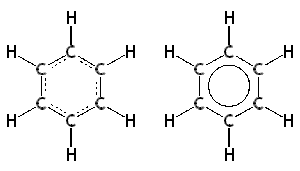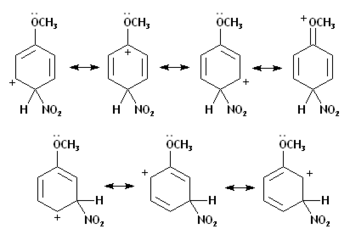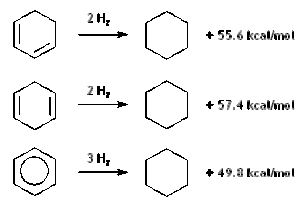User:Pgpotvin/Sandbox
Resonance in chemistry is the depiction of a molecule as a hybrid of conventional Lewis structures that differ only in the placement of the valence electrons, when no single Lewis structure is adequate to describe its true structure and properties. The Lewis structures in resonance situations are inadequate and inaccurate because they do not exist as such, and do not exist as such because they are less stable than the hybrid.
Example
Resonance is depicted using a double-headed arrow ()[1] between pairs of Lewis structures and, to emphasize that only one structure is meant, the group of Lewis structures can be placed within large square brackets. |  |
Resonance Hybrids and Resonance Contributors
[edit]Lewis structures depict molecules by placing pairs of valence electrons between atoms to represent the electron-sharing in covalent bonds, without regard to whether or not the sharing is equal, and by placing other electrons on single atoms, designating them as strictly non-bonding. However, it is often the case that some properties of a molecule can be explained with one Lewis structure but other properties are better explained by another, in which the electrons are placed differently, or that the molecular properties are best explained by an intermediate, called a resonance hybrid, between two or more Lewis structures that are then called canonical, limiting or resonance structures, resonance extremes or resonance contributors. Resonance thus approximately conveys a delocalization of the electrons, something which cannot otherwise be easily drawn, except in certain cases where the resonance structures are equivalent. A more exact description of the hybrid structure and the electron distribution is only available through quantum chemical approaches.
Example
|  |
Since resonance involves combining structures that differ only in the placement of electrons, all resonance contributors must have
- the same atoms, the same number of electrons and the same total charge, otherwise they would be different molecules,
- the same atom connectivity, otherwise they would be constitutional isomers, and
- the same relative disposition of the atoms in three-dimensional space, otherwise they would be conformational isomers.[2]
But the nuclear positions can otherwise vary, since bond lengths and bond angles can differ between non-isomeric resonance contributors.[3]
Relative Importance of Resonance Contributors
[edit]Not all possible resonance contributors to a resonance hybrid are equally relevant to the structure and properties of a molecule, since some will be less stable than others, for instance because some will have fewer bonds. Resonance contributors are qualitatively grouped into two categories, "major contributors" and "minor contributors", according to their perceived importance or "weight" in describing the true structure. The "weighting" of each is a qualitative assessment of the stability of each. "Major" resonance contributors will:
- obey as much as possible the octet rule (8 valence electrons around each atom instead of deficiencies or hypervalencies),
- carry a minimum of charged atoms (unless it serves to create additional bonds to compensate, the separation of + and - charges requires energy),
- place charges on those atoms best able to carry them (negative charge on the most electronegative atoms, positive charge on the least electronegative, unless this serves to create additional bonds).
BENZ
Resonance Stabilization
[edit]In the case of benzene, there is no difference between the two Kekulé structures. Both have the same stability, both have equal weight, and the hybrid can be considered as an average of the two in terms of atomic and electronic localization, but not in terms of energy. This averaging would not occur unless it was advantageous and, in general, resonance hybrids are truer depictions of molecules because they are more stable than their resonance contributors. Were this not so, the hybrids would have no existence, whereas it is the contributing structures that have no existence. Resonance and delocalization are therefore stabilizing.
In other molecules, the contributions of each resonance structure will be unequal, and the stabilization will draw to different extents upon each. Nevertheless, a general rule is that, all else being equal, the greater the number of resonance contributors, the greater the possible resonance-delocalization and the greater the possible stabilization.
Example
|  |
The gain in stability of the resonance hybrid over the most stable of the (non-existent) canonical structures is called the resonance stabilization or resonance energy. This can be measured computationally by quantum chemical approaches or, in some cases, experimentally.
Example
|  |
Occurence
[edit]Resonance in organic chemistry is prevalent in arrangements where a donor group (a lone pair, an unpaired electron, a double bond or a triple bond) and an accepting group (an unpaired electron, an empty p orbital, a double bond or a triple bond) are separated by a single bond, for instance in a diene moiety, a vinyl ether grouping, in stabilized carbenes, in allylic cations, benzylic radicals and so on. All of these situations involve the mixing of p orbitals and double or triple bonds (π bonds), but resonance involving single bonds (σ bonds) has been used in some cases, as illustrated in one example below. Indeed, the unequal sharing of electrons in covalent single bonds can be viewed as a resonance between purely covalent and purely ionic bonds.
There are also many examples in main group chemistry of these same arrangements, for instance in sulfate ion and in boron-nitrogen compounds such as borazine, and several other examples given below. In transition metal chemistry, permanganate (MnO4-) and chromate (CrO42-) ions are analogous, but metal-ligand orbital overlap involving d orbitals and electron delocalization are very common, for instance in π backbonding.
Further Examples
[edit]To generate one resonance contributor from another, one uses a curved arrow to denote the required change in position of electron pairs, or half-headed curved arrows for single electrons, or a cascade of such arrows. The examples below are illustrative.
|
 Major resonance contributors for acetate ion, and a hybrid structure. |
|
 Half-headed arrows are used to denote the movement of single electrons. |
|
 Enol and enolate: resonance in the conjugate base. |
|
 Cyanate resonance structures. |
|
 Resonance in formamide, with a π-donating nitrogen and π-accepting carbonyl group. |
|
 Resonance involving 'major' and 'minor' contributors. |
|
 Resonance involving σ bonds. |
What resonance is not
[edit]The double-headed arrow () used to indicate resonance, the curved arrows used to show electron movement in changing one resonance structure into another, and the unfortunate name resonance itself all suggest a back-and-forth movement of electrons between limiting structures, a sort of vibration akin to the physical phenomenon of resonance, as Kekulé had imagined. However, a dynamic exchange such as this would be associated with an energy that could in principle be slowed or even stopped by lowering the temperature, but the reality is that there is no temperature-dependent electron movement from one limiting structure to another, and no equilibrium between them. There are, however, molecular vibrations which involve nuclear movement.
Relation to molecular orbital theory
[edit]Resonance is a cartoon of the delocalisation that can serve to explain what no single Lewis structure can, but it does not explain why delocalization occurs, except to say that the sharing of electrons is stabilizing. There is no means by which one can quantify that stabilization. Although one can "weigh" the contributions of each "major" or "minor" resonance contributor, one cannot quantify nor graphically depict that weighting. Resonance also does not specify the exact electronic distribution in a resonance hybrid.
Molecular orbital theory can quantify the stabilization resulting from electron delocalisation, convey the resulting electronic distribution and measure the resulting interatomic distances and angles. Molecular orbital theory explains not only π-type bonding (as well as other kinds), but also stabilization by conjugation and hyperconjugation. The mixing of atomic orbitals by overlap in space creates an equal number of hybrids called molecular orbitals (MOs), some of which will be bonding, others anti-bonding and possibly others non-bonding, depending on the number of atomic orbitals. Simply stated, the energies of the anti-bonding MOs will be higher than those of the atomic orbitals while the energies of the bonding MOs will be lower by an equal degree, such that the full population of all the molecular orbitals will be of no energetic advantage, but population of only the bonding and non-bonding orbitals will be stabilizing. The sharing of electrons that resonance depicts translates into the population of lower-energy molecular orbitals.
History
[edit]The concept of resonance was introduced by Linus Pauling in 1928. The term "resonance" came from the analogy between the quantum mechanical treatment of the H2 molecule and a classical system consisting of two coupled oscillators. In the classical system, the coupling produces two modes, one of which is lower in frequency than either of the uncoupled vibrations; quantum-mechanically, this lower frequency is interpreted as a lower energy.
The alternative term mesomerism popular in German and French publications with the same meaning was introduced by Christopher Ingold in 1938 but did not catch on in the English literature. The current concept of mesomeric effect has taken on a related but different meaning. The double headed arrow was introduced by the German chemist Fritz Arndt who preferred the German phrase zwischenstufe or intermediate phase.
Due to confusion with the physical meaning of the word resonance, as no elements actually appear to be resonating, it has been suggested that the term resonance be abandoned in favor of delocalization.[6] Resonance energy would become delocalization energy and a resonance structure becomes a contributing structure. The double headed arrows would be replaced by commas.
See also
[edit]Notes and References
[edit]- ^ The resonance arrow is not to be confused with the opposing harpoons symbolizing chemical equilibria ().
- ^ Whereas isomers may interchange over time through higher-energy transition states and coexist in equilibrium populations governed by their energy differences, resonance contributors do not interchange nor coexist.
- ^ Some authors, for instance Wade (2006), state that the nuclei cannot move, in going from one resonance contributor to another. This implies that the hydridization state of an individual atom cannot change, as that would change its geometry and, therefore, the spatial locations of the atoms to which it is bonded. Since resonance accepts that a pair of atoms will be singly bonded in one resonance contributor but doubly bonded and thus closer together in another, some variation of spatial location is allowed. So long as no isomerism results, different hybridization states are allowable for an atom. For instance, a pyramidal (sp3-hybridized) nitrogen atom in one resonance contributor can be trigonal (sp2-hybridized) in another. The resonance hybrid will have an intermediate geometry (flattened pyramidal, in this case) at that atom arising from a different mix of the native s and p stomic orbitals.
- ^ The increased acidity is also due to the presence of a second electronegative atom.
- ^ A better explanation is that the OH group becomes preferentially attached to the carbon best able to support a positive charge.
- ^ If It's Resonance, What Is Resonating? Kerber, Robert C. . J. Chem. Educ. 2006 83 223. Abstract
Bibliography
[edit]- R. Morrison, R. Boyd: Organic Chemistry, 5th ed. Prentice Hall, 1989; Chapter 10. (ISBN 0-87692-560-3)
- L. Pauling: The Nature of the Chemical Bond, Cornell University Press (1939) (ISBN 0801403332)
- L. G. Wade, Jr.: Organic Chemistry, 6th ed. Prentice-Hall, 2006 (ISBN 0-13-169957-1) <



